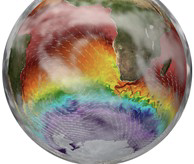Future ocean & climate models need to implement fine-scale processes for improved predictions and projections
To quantify the impact of fine-scale processes in the Agulhas Current system and the impact on larger scales and far-field responses in the Atlantic Ocean we use model hierarchy of numerical models.
The individual model components used in this work package cover the dynamics of the upper ocean, the air-sea exchange, the atmospheric circulation and the biogeochemistry down to the km-scale. Within the range of global ocean and coupled climate models, the Agulhas Current system is used as a focus region. Analyses include quantifications of the large-scale transports such as Agulhas leakage and its impact on the AMOC (Atlantic Meridional Overturning Circulation), the amount of heat and CO2 take up from the atmosphere, and the budgets of biogeochemistry.
Aim and Methodology:
We develop and apply a high-resolution model hierarchy of the ocean and atmosphere in terms of nested grids down to the km-scale. These shall cover all aspects of the ocean observations in terms of ocean dynamics, air-sea exchange, atmospheric circulation and oceanic biogeochemistry. The model hierarchy will expand the limited observations in space and time, will allow to study dynamics, and to scale up by quantifying budgets for the entire Cape Basin and Atlantic Ocean.
New approaches for parameterizations of submesoscale processes, which use artificial intelligence (AI) methodologies, will be developed and applied to parameterize the fine-scale processes in (typically coarser resolved) climate models used for the Climate Model Intercomparison Projects and IPCC reports.
Artificial intelligence methods will also be developed and used (1) to systematically explore and to bias-correct the large volumes of model output; (2) to automatically detect submesoscale structures (e.g., fronts and eddies) in coarser resolutions, which will be developed based on model output and later applied to satellite fields for global use; (3) to fuse naturally limited observational data with model output.



